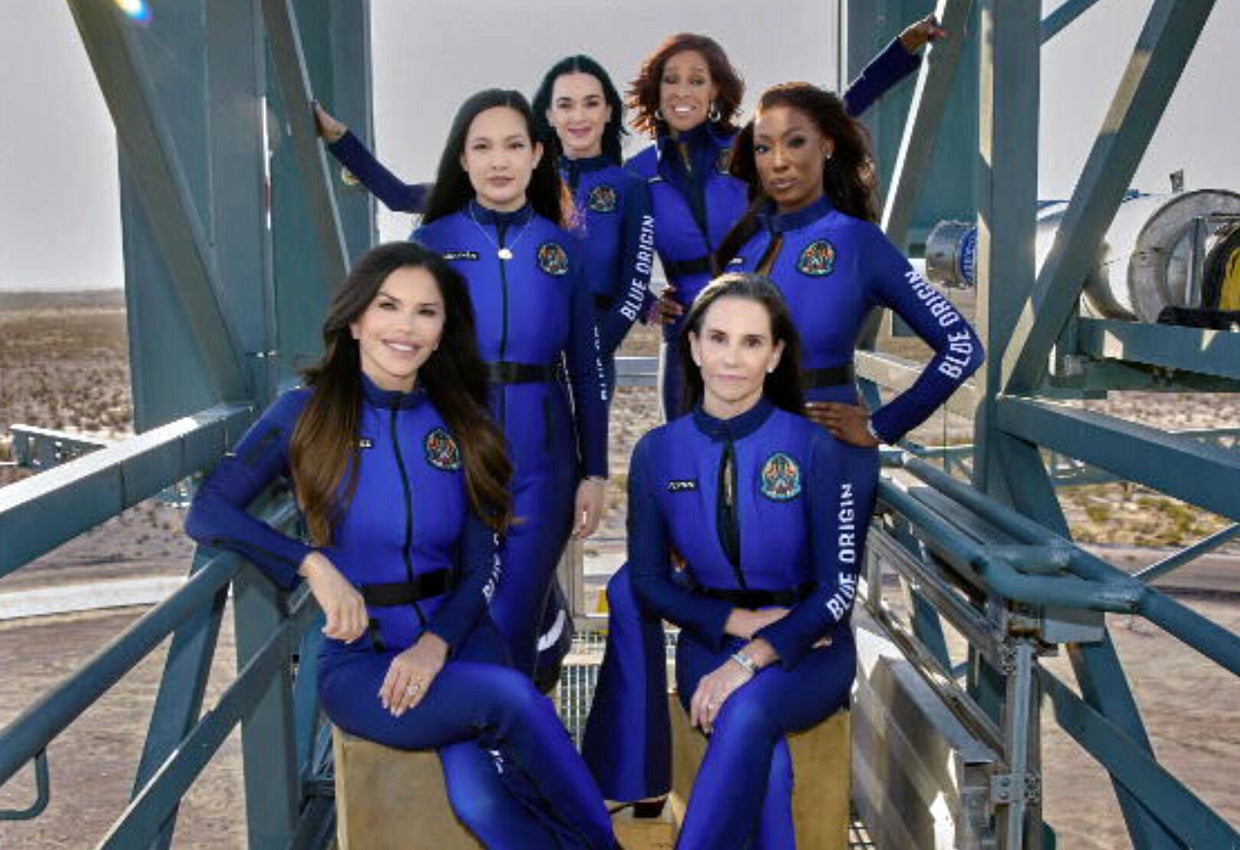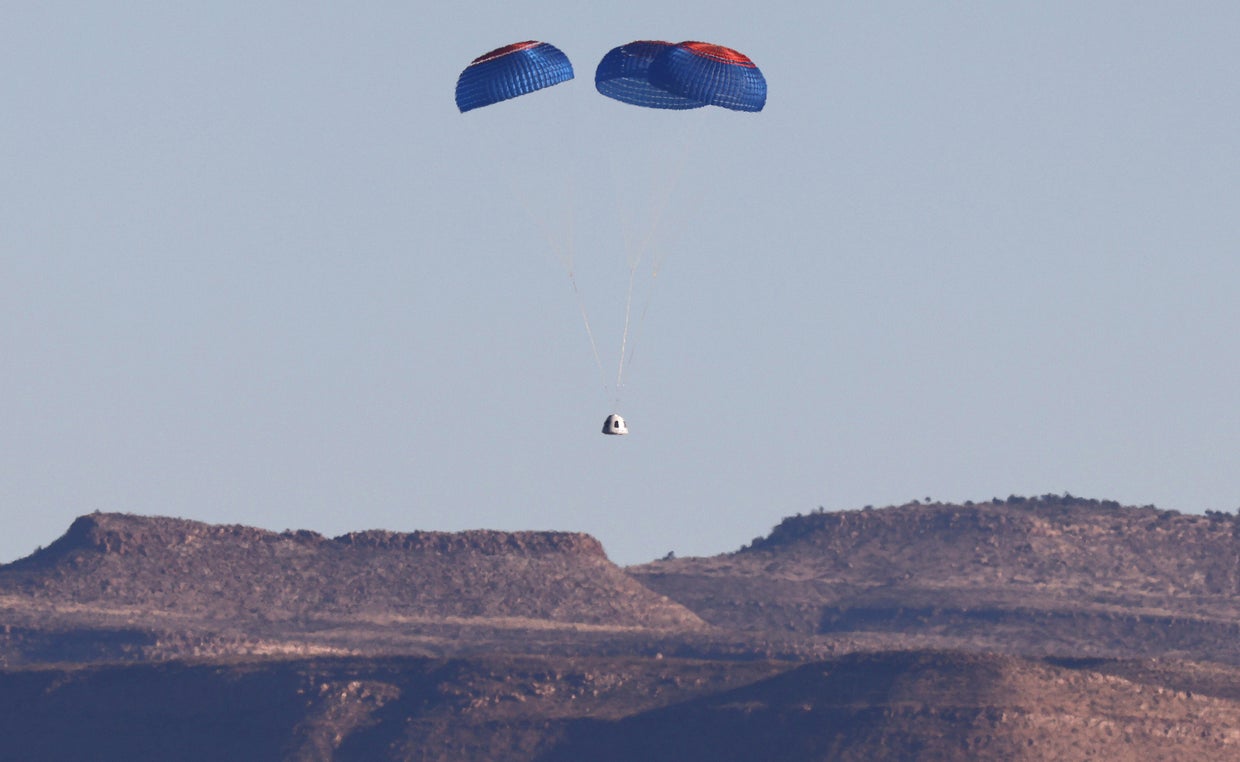Blue Origin’s first all-women flight crew blasted off Monday on a journey 62 miles above Earth’s surface to the Kármán line, the internationally recognized boundary of space. The NS-31 mission marks the 11th human flight of Jeff Bezos’ New Shepard program.
“I can’t even believe what I saw,” marveled “CBS Mornings” co-host Gayle King after returning from the roughly 10-minute journey.
She joined pop superstar Katy Perry, journalist and philanthropist Lauren Sánchez, film producer Kerianne Flynn, former NASA rocket scientist Aisha Bowe, and civil rights activist Amanda Nguyen on Blue Origin’s historic trip to space. Bowe is the first Bahamian and Nguyen the first Vietnamese and Southeast Asian woman in space.
They joined a small group of 52 prior passengers with the New Shepard program who have made the quick trip to space. This is the first all-women crew to lift off in nearly six decades, following Soviet cosmonaut Valentina Tereshkova’s solo spaceflight, Blue Origin said.
Blue Origin’s first all-women crew blasts off
Justin Hamel / Getty Images
The all-women Blue Origin flight crew lifted off on time Monday morning, around 9:30 a.m. ET. You could hear screams of awe inside the capsule as the rocket blasted off and headed toward the Kármán line.
“I got chills. I got tears in my eyes…the enormous burst of sound,” described Duthiers as he watched the rocket disappear into the sky, later saying he could hear King marvel, “Oh, look at that,” from inside the rocket.
At the apex of the mission, the passengers were in microgravity, meaning they experienced weightlessness. They unbuckled and floated in the capsule for about 4 minutes before returning to their seats.
“I thought I heard Katy Perry singing up there, and listen, she had a lot to sing about,” CBS News senior national correspondent Mark Strassman commented after the launch. King confirmed Perry sang Louis Armstrong’s “What A Wonderful World.”
The booster then made its way back to Earth, landing upright about 2 miles from the launchpad as the capsule successfully landed back on the ground.
Crew members react after returning to Earth
After a brief safety check, the hatch was opened and each of the astronauts were allowed to exit the capsule one by one.
Sánchez was the first to walk through the doors, hugging fiancé Bezos. Perry was the next to exit, pointing at the sky with a smile on her face before kissing the ground. Nguyen then popped out, pumped her fists and cheered with the crowd on the ground. Bowe followed closely behind, also raising her arms. King then walked down the stairs.
“I just have to have a moment with the ground…to appreciate the ground for just a second,” said King as she got on her knees and kissed the ground before commenting “that was amazing.”
Flynn was the final crew member to exit, chanting, “I went to space!”
“I’m so proud of you,” Bezos said as he gave Flynn a hug.
Gayle King describes space journey
Blue Origin / CBS Mornings
Jumping up and down after the journey to space, King said she wouldn’t call it a “ride” but a “bona fide freakin’ flight.” She said that she’s proud of herself for overcoming her fear of flying.
King described the Kármán line as being “oddly quiet” and “peaceful.”
“You look down at the planet and you think, ‘That’s where we came from?’ To me, it’s such a reminder about how we need to do better – be better,” said King, adding that she’ll “never, ever, ever forget it.”
Though they all trained for it, King said microgravity was “very difficult,” particularly when you had to get back into your seat and strap in to make the trip back down.
“I looked like a freakin’ moose getting in the chair,” King joked. “It was like, ‘Just let me get in the chair! Let me get the seatbelt on!”
But Perry quickly soothed her panic by singing “What A Wonderful World.”
“Isn’t that nice?” said King, calling it really special.
Blue Origin launch timeline
Here’s a rundown of the Blue Origin launch, from preparations to liftoff:
- 8:45 a.m. ET: Blue Origin crew arrives
- 8:55 a.m. ET: Blue Origin crew enters the capsule and members get strapped in
- 9:06 a.m. ET: Hatch closes
- 9:30 a.m. ET: Launch window opens
- 9:40 a.m. ET: Crew cruises back home
- 9:55 a.m. ET: Hatch opens and crew begins to exit
CBS News New York meteorologist John Elliott said there were “almost perfect conditions” Monday morning in West Texas, where the capsule launched. “Winds are calm. Visibility is great.”
History of Blue Origin’s New Shepard flights
Blue Origin named its New Shepard program after astronaut Alan Shepard, the first American to fly in space, who piloted Mercury’s Freedom 7 capsule in May 1961 on its launch from Cape Canaveral, Florida.
The program helps bring citizens to space in a reusable suborbital rocket system. Bezos, the founder of Blue Origin, set the stage for future human spaceflights with the program when he lifted off on a capsule, named “First Step,” in 2021 with three crewmates.
“My expectations were high, and they were drastically exceeded. The zero G (gravity) piece may have been one of the biggest surprises because it felt so normal, it felt almost like humans evolved to be in that environment. … It’s a very pleasurable experience,” Bezos told reporters after the successful 2021 spaceflight.
The unpiloted New Shepard capsule has space for six passengers who each have a window seat, looking out of some of the largest windows of any operational spacecraft.
Blue Origin says the goal of the New Shepard program is also to advance research.
“New Shepard payload flights support a wide range of research, education, and technology development,” the company added.
How long was Gayle King and the crew in space?
The journey to space and back, from liftoff to landing, lasted for about 11 minutes. Nearly three minutes into liftoff, the crew capsule separated from the booster and eventually reached the apogee, or the highest point of the flight.
They floated for about 4 minutes before they made their return to Earth. First, drogue parachutes deployed followed by the main parachutes, bringing the history-making crew back down to the ground. They landed at less than 15 miles per hour, astronaut Mae Jemison, the first woman of color to travel to space, explained to “CBS Mornings” on Monday.
“New Shepard astronauts ascend toward space at more than three times the speed of sound. They pass the Kármán line, the internationally recognized boundary of space 62 miles above Earth, before unbuckling to float weightless and gaze at our planet. The crew returns gently under parachutes, forever changed,” Blue Origin describes on its website.
About Blue Origin’s first all-women crew
Blue Origin
- Gayle King: “CBS Mornings” co-host Gayle King, who recently celebrated her 70th birthday, explained that participating in a spaceflight represents an unexpected turn in her life and career. “I can’t even believe what I saw,” she said post-launch.
- Katy Perry: Pop superstar Katy Perry performed a tribute to Earth during her journey as part of the historic all-women space crew mission. “I think the perspective that we’re all going to walk away from is like, ‘Oh, my gosh, we have to protect our mother,'” Perry said ahead of the spaceflight.
- Lauren Sánchez: Lauren Sánchez, who is engaged to Amazon and Blue Origin founder Jeff Bezos, helped assemble the all-women crew. She has many titles: Journalist, philanthropist and helicopter pilot, to name a few. She said the groundbreaking idea came to her immediately after Bezos returned from his journey beyond Earth’s atmosphere. “Within 24 hours, he’s like, ‘Would you ever go up?’ I was like, ‘What?’ I was like, ‘Yes, I would go up.'” “In that exact moment, I said, ‘Could I take all women up?'” Sánchez said. “And he goes, ‘That’s a great idea.'”
- Aisha Bowe: Aisha Bowe, a former NASA rocket scientist and two-time tech company founder, made history as the first person of Bahamian heritage to travel to space. She said she had “been preparing for this moment my entire life.”
- Amanda Nguyen: Civil rights activist and astronaut Amanda Nguyen, who drafted the Sexual Assault Survivor Bill of Rights and played a key role in the act’s 2016 passage, made history as the first Vietnamese and Southeast Asian woman in space. Nguyen told “CBS Mornings” about her plans to conduct two science experiments during Monday’s spaceflight — one focused on plant pathology in partnership with the Vietnamese National Space Center and the second on women’s health, specifically menstruation.
- Kerianne Flynn: For American film producer Kerianne Flynn, gazing at the stars as a child in Michigan has evolved from wonder to reality, telling “CBS Mornings”: “I went through my life, my career and never really thought that going up there to be among those stars was a possibility. And now it’s a reality.”
Unique design of Blue Origin’s New Shepard spacecraft
Blue Origin’s spacecraft carries a crew of six and is fully autonomous, not controlled by a pilot on board.
The crew capsule sits atop a liquid-hydrogen-fueled booster, which launches straight upwards, reaching a velocity of about 2,200 mph and subjecting the passengers to 3G — three times the normal force of gravity — before main engine cutoff, about two-and-a-half minutes into the flight.
At an altitude of about 45 miles, the crew capsule is then released to continue soaring out of the lower atmosphere on its own, while the reusable booster heads back down to Earth to land on a nearby pad.
About three-and-a-half minutes after lifoff, the crew capsule reaches a maximum altitude of just above 62 miles — the Kármán line, which the Fédération Aéronautique Internationale, an international body that certifies aerospace records, considers the dividing line between the discernible atmosphere and space.
The crew experiences weightlessness from the moment the capsule separates from the booster until it arcs over the top of the trajectory and begins its descent. Moments after separating from the booster, passengers are able to unstrap and float about the cabin while enjoying spectacular views of Earth.
After a few extraordinary minutes, though, it’s time to strap in for the return home.
“It’s about three minutes before the astronauts will get a warning to get back into their seats. And at that point, they have about 30 seconds. It’s not going to be a rush, it’s going to be very leisurely. All they have to do is be sitting in the seat and then as the G forces come on, our reentry will naturally push them back in the seat, so they have plenty of time to buckle back in,” Gary Lai, a former Blue Origin engineer who helped design the New Shepard, said in an earlier interview with CBS News.
Plunging back into the lower atmosphere, the capsule will rapidly decelerate, briefly subjecting the passengers to more than five times the normal force of gravity, before three large parachutes unfurl to slow the descent to about 16 mph. An instant before touchdown, pressurized nitrogen gas thrusters fire to slow the descent to walking pace.
Mario Tama / Getty Images
The New Shepard vehicle has a number of safeguards built in. It is equipped with a “full envelope escape system” that would propel the crew capsule away from a malfunctioning booster at any point from the launch pad on up, using an Aerojet Rocketdyne solid-fuel rocket motor embedded in the capsule.
“It will activate in a fraction of a second, it will light off and propel the capsule away from the booster to safety,” Lai explained. “Once it’s far away, parachutes will deploy and we will execute a normal landing.”
The system is also designed to ensure a survivable landing even if two of the main parachutes fail to open and fully inflate.

















Leave a Reply